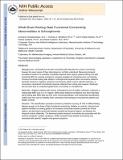Whole brain resting state functional connectivity abnormalities in schizophrenia
Author(s)
Venkataraman, Archana; Whitford, Thomas J.; Westin, Carl-Fredrik; Golland, Polina; Kubicki, Marek
DownloadGolland_Whole brain.pdf (1.332Mb)
PUBLISHER_CC
Publisher with Creative Commons License
Creative Commons Attribution
Terms of use
Metadata
Show full item recordAbstract
Background
Schizophrenia has been associated with disturbances in brain connectivity; however the exact nature of these disturbances is not fully understood. Measuring temporal correlations between the functional MRI time courses of spatially disparate brain regions obtained during rest has recently emerged as a popular paradigm for estimating brain connectivity. Previous resting state studies in schizophrenia explored connections related to particular clinical or cognitive symptoms (connectivity within a-priori selected networks), or connections restricted to functional networks obtained from resting state analysis. Relatively little has been done to understand global brain connectivity in schizophrenia.
Methods
Eighteen patients with chronic schizophrenia and 18 healthy volunteers underwent a resting state fMRI scan on a 3 T magnet. Whole brain temporal correlations have been estimated using resting-state fMRI data and free surfer cortical parcellations. A multivariate classification method was then used to indentify brain connections that distinguish schizophrenia patients from healthy controls.
Results
The classification procedure achieved a prediction accuracy of 75% in differentiating between groups on the basis of their functional connectivity. Relative to controls, schizophrenia patients exhibited co-existing patterns of increased connectivity between parietal and frontal regions, and decreased connectivity between parietal and temporal regions, and between the temporal cortices bilaterally. The decreased parieto-temporal connectivity was associated with the severity of patients' positive symptoms, while increased fronto-parietal connectivity was associated with patients' negative and general symptoms.
Discussion
Our analysis revealed two co-existing patterns of functional connectivity abnormalities in schizophrenia, each related to different clinical profiles. Such results provide further evidence that abnormalities in brain connectivity, characteristic of schizophrenia, are directly related to the clinical features of the disorder.
Date issued
2012-08Department
Massachusetts Institute of Technology. Computer Science and Artificial Intelligence Laboratory; Massachusetts Institute of Technology. Department of Electrical Engineering and Computer ScienceJournal
Schizophrenia Research
Publisher
Elsevier
Citation
Venkataraman, Archana, Thomas J. Whitford, Carl-Fredrik Westin, Polina Golland, and Marek Kubicki. “Whole Brain Resting State Functional Connectivity Abnormalities in Schizophrenia.” Schizophrenia Research 139, no. 1–3 (August 2012): 7–12.
Version: Author's final manuscript
ISSN
09209964